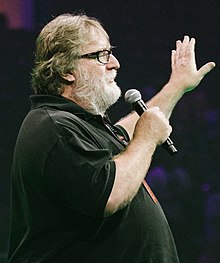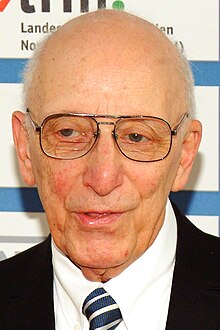The Video Games Portal

A video game or computer game is an electronic game that involves interaction with a user interface or input device (such as a joystick, controller, keyboard, or motion sensing device) to generate visual feedback from a display device, most commonly shown in a video format on a television set, computer monitor, flat-panel display or touchscreen on handheld devices, or a virtual reality headset. Most modern video games are audiovisual, with audio complement delivered through speakers or headphones, and sometimes also with other types of sensory feedback (e.g., haptic technology that provides tactile sensations). Some video games also allow microphone and webcam inputs for in-game chatting and livestreaming.
Video games are typically categorized according to their hardware platform, which traditionally includes arcade video games, console games, and computer (PC) games; the latter also encompasses LAN games, online games, and browser games. More recently, the video game industry has expanded onto mobile gaming through mobile devices (such as smartphones and tablet computers), virtual and augmented reality systems, and remote cloud gaming. Video games are also classified into a wide range of genres based on their style of gameplay and target audience. (Full article...)
Featured articles –
Kingdom Hearts II is the third game in the Kingdom Hearts series, and takes place one year after the events of Kingdom Hearts: Chain of Memories. Sora, the protagonist of the first two games, returns to search for his lost friends while battling the sinister Organization XIII, a group of antagonists previously introduced in Chain of Memories. Like previous games, Kingdom Hearts II features a large cast of characters from Disney and Square Enix properties.
Concepts for Kingdom Hearts II began during the end of development of Kingdom Hearts Final Mix, with the game entering full development in 2003 and being announced at Tokyo Game Show 2003. Most of the first game's development team returned, including director Tetsuya Nomura, with the game being developed concurrently with Chain of Memories. In developing Kingdom Hearts II, the development team sought to address user feedback from the first game, give the player more freedom and options in combat and present a deeper and more mature plot. (Full article...)
The story for The Battle for Middle-earth II is divided into Good and Evil Campaigns. The Good Campaign focuses on Glorfindel, an Elf who is alerted to a planned attack on the Elven sanctuary of Rivendell. With help from the Dwarves and other Good forces, the Elves attempt to eliminate Sauron and his army to restore peace in Middle-earth. In the Evil Campaign, Sauron sends the Mouth of Sauron and the Nazgûl to muster wild Goblins. With his army, Sauron moves forward with his plan to destroy the remaining Good forces in the North. The Windows version of the game was released in March 2006 and the Xbox 360 version was released in July 2006.
The Battle for Middle-earth II received generally favorable reviews from video game critics. Reviews praised the game's integration of the Lord of the Rings universe into a real-time strategy title, while criticism targeted the game's unbalanced multiplayer mode. The Battle for Middle-earth II received numerous awards, including the Editors' Choice Award from IGN. At the end of March 2006, The Battle for Middle-earth II reached fourth in a list of the month's best-selling PC games. A Windows expansion pack for the game was released in November 2006, called The Rise of the Witch-king, which features a new faction known as Angmar, new units, and several gameplay improvements. The official game servers were shut down for Windows in 2010 and Xbox 360 in 2011, however Windows users may still play online using unofficial game servers. (Full article...)
Colossal Cave Adventure (also known as Adventure or ADVENT) is a text-based adventure game, released in 1976 by developer Will Crowther for the PDP-10 mainframe computer. It was expanded upon in 1977 by Don Woods. In the game, the player explores a cave system rumored to be filled with treasure and gold. The game is composed of dozens of locations, and the player moves between these locations and interacts with objects in them by typing one- or two-word commands which are interpreted by the game's natural language input system. The program acts as a narrator, describing the player's location and the results of the player's attempted actions. It is the first well-known example of interactive fiction, as well as the first well-known adventure game, for which it was also the namesake.
The original game, written in 1975 and 1976, was based on Crowther's maps and experiences caving in Mammoth Cave in Kentucky, the longest cave system in the world; further, it was intended, in part, to be accessible to non-technical players, such as his two daughters. Woods's version expanded the game in size and increased the number of fantasy elements present in it, such as a dragon and magic spells. Both versions, typically played over teleprinters connected to mainframe computers, were spread around the nascent ARPANET, the precursor to the Internet, which Crowther was involved in developing.
Colossal Cave Adventure was one of the first teletype games and was massively popular in the computer community of the late 1970s, with numerous ports and modified versions being created based on Woods's source code. It directly inspired the creation of numerous games, including Zork (1977), Adventureland (1978), Mystery House (1980), Rogue (1980), and Adventure (1980), which went on to be the foundations of the interactive fiction, adventure, roguelike, and action-adventure genres. It also influenced the creation of the MUD and computer role-playing game genres. It has been noted as one of the most influential video games, and in 2019 was inducted into the World Video Game Hall of Fame by The Strong and the International Center for the History of Electronic Games. (Full article...)
Wolfenstein 3D was the second major independent release by id Software, after the Commander Keen series of episodes. In mid-1991, programmer John Carmack experimented with making a fast 3D game engine by restricting the gameplay and viewpoint to a single plane, producing Hovertank 3D and Catacomb 3-D as prototypes. After a design session prompted the company to shift from the family-friendly Keen to a more violent theme, programmer John Romero suggested remaking the 1981 stealth shooter Castle Wolfenstein as a fast-paced action game. He and designer Tom Hall designed the game, built on Carmack's engine, to be fast and violent, unlike other computer games on the market at the time. Wolfenstein 3D features artwork by Adrian Carmack and sound effects and music by Bobby Prince. The game was released through Apogee in two sets of three episodes under the shareware model, in which the first episode is released for free to drive interest in paying for the rest. An additional episode, Spear of Destiny, was released as a stand-alone retail title through FormGen.
Wolfenstein 3D was a critical and commercial success and is considered one of the greatest video games ever made. It garnered numerous awards and sold over 250,000 copies by the end of 1995. It has been termed the "grandfather of 3D shooters", and is widely regarded as having helped popularize the first-person shooter genre and establishing the standard of fast-paced action and technical prowess for many subsequent games in the genre, as well as showcasing the viability of the shareware publishing model at the time. FormGen developed an additional two episodes for the game, while Apogee released a pack of over 800 fan-created levels. Id Software never returned to the series, but did license the engine to numerous other titles before releasing the source code for free in 1995, and multiple other games in the Wolfenstein series have been developed by other companies since 2001. (Full article...)
Sonic Team began developing Sonic Adventure in 1997, after the cancellation of the Sega Saturn game Sonic X-treme. Led by director Takashi Iizuka and producer Yuji Naka, the team strove to reinvent Sonic for the 3D era of video games. Adventure features a stronger emphasis on storytelling and role-playing elements in contrast to previous Sonic games, while Yuji Uekawa redesigned the series's characters for their transition to 3D. Sonic Team attempted to demonstrate the technical prowess of the Dreamcast with realistic graphics and drew inspiration from locations in Peru and Guatemala. The soundtrack was primarily composed by Jun Senoue, who preferred rock music over the electropop of previous Sonic games.
Following its reveal at the Tokyo International Forum in August 1998, Sonic Adventure was highly anticipated and was released in Japan in December 1998, North America in September 1999, and Europe in October 1999. It received critical acclaim and became the Dreamcast's bestseller, with 2.5 million copies sold by August 2006. Reviewers considered Adventure a major technical advancement and praised the visuals and gameplay. Though critics noted glitches and camera problems, and reactions to the audio were mixed, they considered Sonic Adventure an exceptional game; some speculated that it could help re-establish Sega as the dominant console manufacturer after the unsuccessful Saturn. (Full article...)
Rare began working on Donkey Kong 64 in 1997, following the completion of Donkey Kong Country 3 (1996). It was conceived as a 2.5D platformer similar to Country before becoming a more open-ended game using the engine from Rare's Banjo-Kazooie (1998). A 16-person team with many recruits from the Banjo group finished it in 1999. It was published by Nintendo in North America in November and worldwide in December. Donkey Kong 64 was the first game to require the Nintendo 64 Expansion Pak, an accessory that added memory resources. The US$22 million marketing campaign included advertisements, sweepstakes, and a national tour.
Donkey Kong 64 received acclaim and was Nintendo's top seller during the 1999 holiday season; it ultimately sold 5.27 million copies worldwide. It won the 1999 E3 Game Critics award for Best Platform Game and multiple awards and nominations from magazines. Reviewers praised the exceptional size and length, but criticized its camera controls and emphasis on item collection and backtracking. Some cited its gameplay and visual similarities to Banjo-Kazooie as a detriment. Critics said Donkey Kong 64 did not match the revolutionary impact of Donkey Kong Country but was still among the Nintendo 64's best 3D platform games. (Full article...)
The game was developed by a team of twelve people, who took two months to make a playable demo and three more to finish the game. Infinity Blade was intended to demonstrate the new iOS version of the Unreal Engine, and to combine the combat of Karateka and Prince of Persia with the loneliness of Shadow of the Colossus. The game received four free expansions that added new equipment, endings, and game modes.
Infinity Blade was the fastest-grossing app in the history of iOS upon its release. It made US$1.6 million in its first four days, and over US$23 million by the end of 2011. It was well received by gaming critics. Reviews praised the graphics and compared the mobile game favorably to console games. Critics also praised the swipe-based combat system, but split opinions on the cyclical gameplay as either addictive or repetitive. Chair later released an arcade port and two sequels: Infinity Blade II and Infinity Blade III. Author Brandon Sanderson also wrote two novellas set between the games: Infinity Blade: Awakening and Infinity Blade: Redemption. (Full article...)
Did you know... -
- ... that classified documents of the United States were partially leaked onto a Discord server for the video game Minecraft?
- ... that LittleBigPlanet, a video game that allows the player to create levels, coincided with the rise of user-generated content?
- ... that development on the video game Expeditions: Rome was not affected by lockdowns from the COVID-19 pandemic because the developer was already split between Copenhagen and Istanbul?
- ... that the album series Jingle Cats spawned Jingle Dogs, Jingle Babies, and a Japanese video game in which "the object is to breed and care for cats, which begin to sing when they're done copulating"?
- ... that for at least 90 minutes, Mori Calliope livestreamed herself begging video game developer Atlus to allow her to stream their game Persona 3?
- ... that the 1999 video game Interplay Sports Baseball Edition 2000 used a public-address announcer while its rivals were switching to two commentators as featured on real MLB game broadcasts?
- ... that a version of the video game Rhino Rumble was not released due to the creators not wanting to add licensed characters?
- ... that before Sarah Elmaleh voiced the player character in the video game Anthem, developed by BioWare, she voiced characters in a mod of an earlier BioWare game?
- ... that deceased YouTuber Technoblade beat the video game Minecraft in hardcore mode using a racing-wheel controller?
- ... that the 2005 video game Bokura no Kazoku was inspired in part by the birth of its creator's first child?
- ... that the illustrations in the 1992 video game Tetris Classic are based on scenes from Alexander Pushkin's poem Ruslan and Ludmila?
- ... that in the upcoming video game Marvel's Midnight Suns, players will be able to create their own superhero in the Marvel Universe?
Selected biography –
Selected image -
Recent video game-related events
- May 24, 2024 – Uvalde school shooting
- Families in Uvalde, Texas, U.S., file a lawsuit against Daniel Defense and Activision Blizzard for creating the DDM4 V7 gun and promoting the weapon through the game Call of Duty, respectively. They also sue Meta Platforms for owning Instagram, which was used by the gunman. (AP)
- April 16, 2024 – 2023–2024 video game industry layoffs
- American video game company Take-Two Interactive lays off 5% of its workforce. (Reuters)
- April 10, 2024 – 2023–2024 video game industry layoffs
- American video game company Epic Games announces that it will lay-off around 870 employees, roughly one-sixth of its workforce, due to slower growth than expected. (CBC via Yahoo! News)
Topics
Categories
Things you can do
In other Wikimedia projects
The following Wikimedia Foundation sister projects provide more on this subject:
-
Commons
Free media repository -
Wikibooks
Free textbooks and manuals -
Wikidata
Free knowledge base -
Wikinews
Free-content news -
Wikiquote
Collection of quotations -
Wikisource
Free-content library -
Wikiversity
Free learning tools -
Wiktionary
Dictionary and thesaurus














































